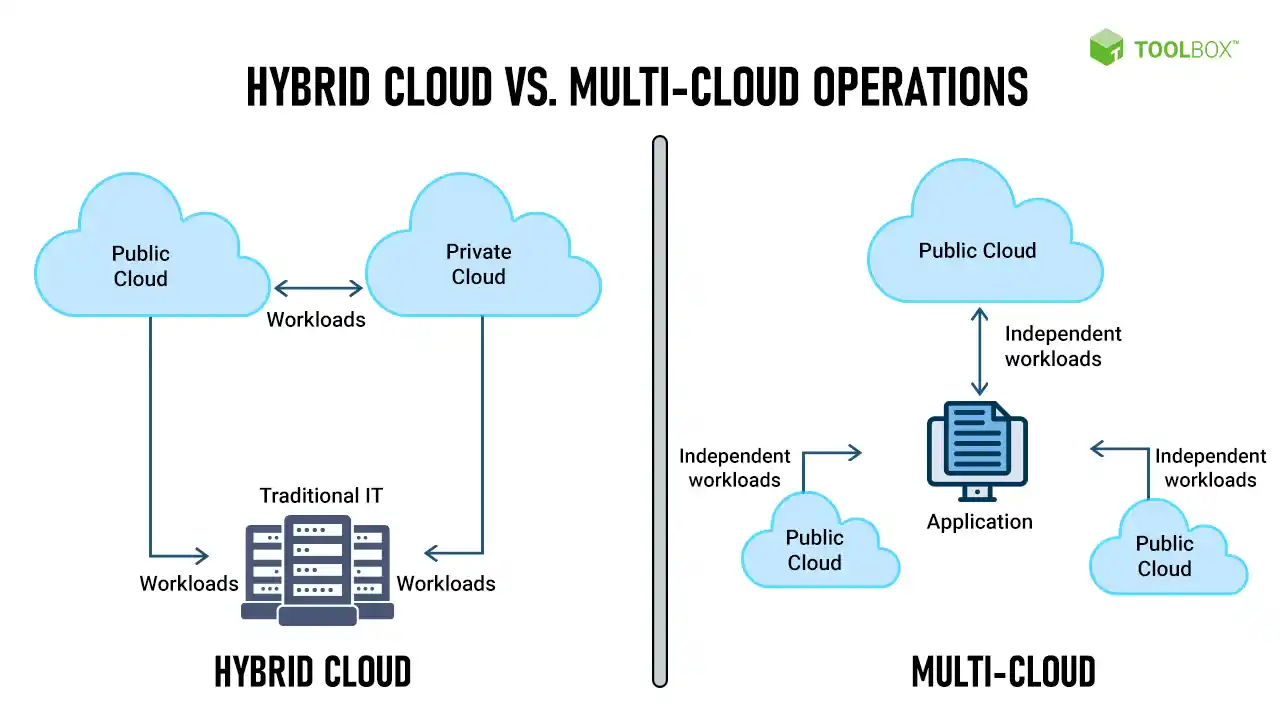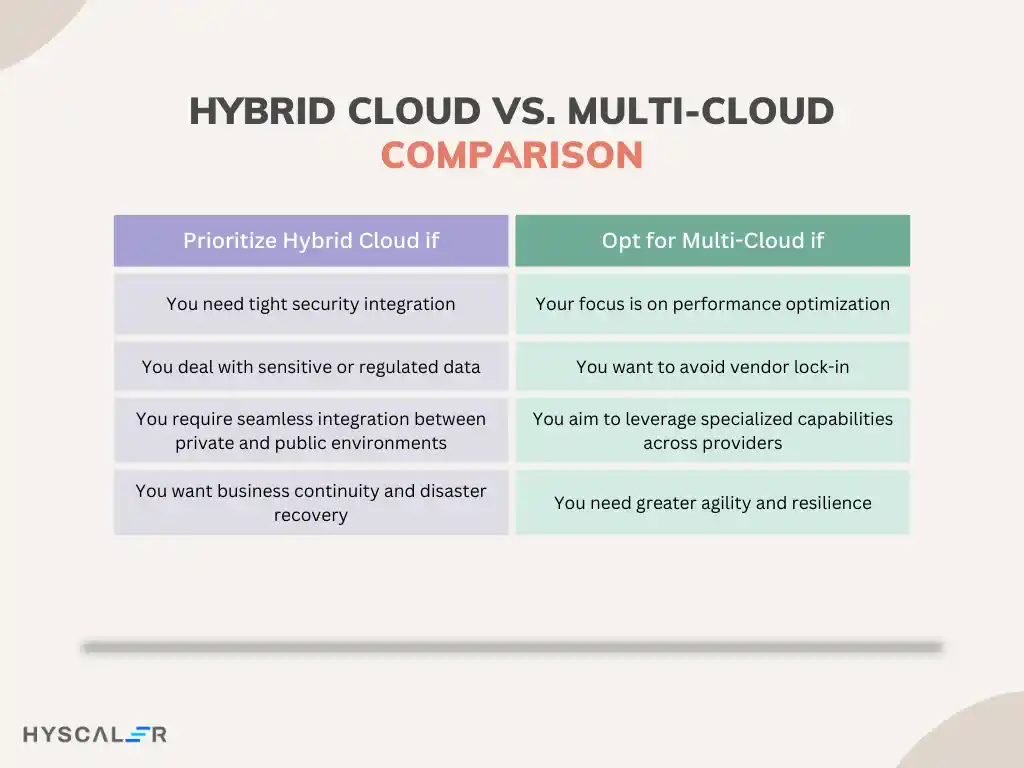Table of Contents
The technology landscape constantly shifts, and cloud computing is at the heart of this transformation. But when it comes to choosing the right cloud strategy, enterprises face a pivotal question: Hybrid Cloud vs Multi-Cloud? Both paradigms offer unique advantages, yet their differences can significantly impact how businesses operate and innovate.
This isn’t just a technical decision—it’s a strategic choice that could shape the trajectory of an organization’s growth and resilience in an increasingly competitive market. Let’s unravel this choice of Hybrid Cloud vs Multi-Cloud together.
The Cloud Revolution
Imagine a world where enterprises can seamlessly scale their operations to meet global demands, processing vast amounts of data with unparalleled agility. Cloud computing has made this a reality, transforming how businesses function in the digital age. In 2022 alone, nearly 94% of enterprises reported relying on cloud services, highlighting its ubiquity and significance.
However, with great power comes great responsibility, and organizations must carefully chart their course. The critical question remains: Hybrid Cloud vs Multi-Cloud which will drive their success?
Picture this: A company that aggregates data on every continent and can ramp up its operations overnight. This is the potential of cloud computing, which market is expected to grow at a high compound annual growth rate (CAGR) of 17.5% to a size of $1.2 trillion by 2027. However, with this growth comes complexity—and the necessity to adopt the right cloud approach between Hybrid Cloud vs Multi-Cloud.
Defining Hybrid Cloud vs Multi-Cloud
Hybrid Cloud: The orchestra of private and public cloud spaces playing together in harmony. It’s the favorite approach among organizations that want to be very agile while maintaining the security of privacy-sensitive data.
It also makes it possible to provide a context-sensitive and logical integration within a Hybrid Cloud of such an unprecedented scale, enabling the dynamic provisioning of resources according to real-time needs without compromising mission-critical functionalities that are safely confined within a private domain.
For firms dealing with tight compliance rules, or, demand, variations in workload, this method provides an ideal balance of control, reusability, and affordability.
Multi-Cloud: A diverse landscape of public clouds from various vendors picked based on their individual strengths. Multi-Cloud is all about horizontalization, performance tuning, and freedom from vendor lock-in.
Through the harnessing of the inherent specific strengths of various providers, companies can individually assemble a solution to adapt to the wide range of their needs.
All from tapping into cutting-edge AI powerhouses of Google Cloud to the power of AWS’s storage, the Multi-Cloud approach enables companies to harness innovation and robustness best, while hedging a potential service interruption or cost increase from a single vendor.

The Data Speaks
As per the Gartner 2023 report, 90% of enterprises will have the strategy of hybrid or multi-cloud by 2025, highlighting the need to grasp Hybrid Cloud vs Multi-Cloud differences. Using this statistic, it is evident that when selecting a cloud strategy as this exists, it is not merely a technical necessity, but a pillar of competitive advantage.
With global organization growth and the increasing influx of data volume, Hybrid Cloud vs Multi-Cloud solutions offer the flexibility and resilience necessary to remain one step ahead.
Here’s a breakdown of Hybrid Cloud vs Multi-Cloud strengths:
Hybrid Cloud Advantages:
- Enhanced Security: Ideally suited for applications in healthcare and finance, areas where strict data control is required. By hosting confidential jobs in private clouds, companies can reduce risk and continue to scale compliance with industry standards.
- Cost Optimization: Companies can archive demanding workloads on the public cloud and benefit from its scalability while relegating proprietary cloud infrastructure for data that has strict security requirements or for mission-critical operations where minimizing latency is a top priority while optimizing overall cost.
- Seamless Workload Migration: The transition from public to public area is more transitionable and, thus well suited to dynamic applications, like demand spikes for a particular season or a disaster recovery scenario. This adaptability reduces downtime and ensures business continuity.
Multi-Cloud Advantages:
- Avoiding Vendor Lock-In: Diversification amongst the providers reduces vendor lock-in, providing both flexibility and bargaining power. With this approach, companies are able to quickly adapt to real-time changes in marketplace conditions.
- Best-of-Breed Solutions: Companies can pick and choose services, such as AI offered by Google Cloud, powerful analytics offered by Azure, or database management offered by AWS, and build solutions that meet specific requirements. With this method, organizations can continue to be at the progressive edge of technological innovation.
- Risk Mitigation: Service outages from one provider won’t cripple operations. Multi-Cloud provides a guarantee of uptime by distributing the workloads across multiple providers, which increases resilience. Most useful for multinational corporations that need continuous operations.
Real-World Examples of Hybrid Cloud vs Multi-Cloud
Let’s bring Hybrid Cloud vs Multi-Cloud to life with real-world applications:
- Hybrid Cloud in Action: A retail juggernaut deploys a private cloud for customer payment information (to meet compliance) and a public cloud for artificial intelligence-powered inventory control. This dual approach balances security with operational efficiency.
- Multi-Cloud in Action: A global technology company is leveraging the DevOps tools within Microsoft Azure, and the machine learning of Google Cloud to bring innovation to life. Through this approach, the firm is able to glean the optimal from each of the platforms, whilst retaining operational flexibility.
Making the Choice
The decision between Hybrid Cloud vs Multi-Cloud depends on specific business requirements and goals.
Prioritize Hybrid Cloud if:
- You need tight security integration: Hybrid Cloud enables private cloud storage of sensitive information to be backed by the public cloud for less sensitive tasks, to maintain compliance with security requirements. According to Gartner, by 2025, 80% of enterprises will implement Hybrid Cloud for security and compliance reasons.
- You deal with sensitive or regulated data: Hybrid Cloud assists enterprises in maintaining control of sensitive data, and operating scalable public cloud for their other use cases. According to IDC, 47% of organizations consider security and compliance as one of the main factors to consider when making the decision for a Hybrid Cloud.
- You require seamless integration between private and public environments: It is most suited for organizations that have on-premise infrastructure but desire integration with cloud services, with minimal disruption. Hybrid Cloud adoption in 2023 increased by 18% according to Forrester.
- You want business continuity and disaster recovery: Using Hybrid Cloud, an organization may backup its data to the public cloud, which enables uninterrupted operation in case of an on-premise failure. According to IDC, 63% of organizations are using Hybrid Cloud to enhance disaster recovery.
Opt for Multi-Cloud if:
- Your focus is on performance optimization: Multi-Cloud enables companies to choose the optimal cloud provider for each workload, resulting in better performance. According to Flexera’s (2023) State of the Cloud Report, 92% of enterprises have migrated their workloads to a Multi-Cloud model to improve their workload performance.
- You want to avoid vendor lock-in: Multi-Cloud decreases dependence on a single cloud provider, enabling entities to change cloud providers whenever required. Forrester reports that 55% have adopted Multi-Cloud to circumvent vendor lock-in and decrease the cost.
- You aim to leverage specialized capabilities across providers: Take advantage of the unique features of providers’ cloud tools to cater to individual business requirements. For instance, Google Cloud is a leader in AI features, whereas AWS is a market leader in computing power. IDC research indicates that 41% of organizations are using at least three cloud providers in order to benefit from specialized services.
- You need greater agility and resilience: Using Multi-Cloud, one can distribute workloads over different providers achieve business continuity, and reduce the risk of outages. Gartner finds that 75% of companies implementing Multi-Cloud concepts list resilience and risk mitigation as leading factors.
In the end, the decision between Hybrid Cloud vs Multi-Cloud relies on the business’s requirements. Hybrid Cloud suits organizations that value security, compliance, and smooth integration with an on-premise infrastructure best, while Multi-Cloud is suited for organizations requiring at the very least improved performance, flexibility, and a decoupled relationship with vendors.

Emerging Trends
With the development of emerging technologies, such as edge computing and AI, the limits of what is achievable are gradually challenged, leading to a lot of changes in cloud computing strategies.
These breakthroughs allow real-time data processing, improved decision-making, and increased flexibility at the edge, and it become increasingly viable to combine the advantages of Hybrid Cloud vs Multi-Cloud models.
With the increasing demand on organizations to make use of the scalability of the public cloud, the control of the private cloud, and the unique abilities offered by more providers, the distinction between Hybrid Cloud vs Multi-Cloud approaches is getting looser.
For instance, edge computing complements cloud strategies by processing data closer to where it is generated, reducing latency and improving performance for critical applications like IoT, autonomous vehicles, and smart cities.
In the meantime, AI improves such environments by providing predictive analytics, automation, and intelligent resource management across a variety of cloud infrastructures.
Final Thoughts
The competition of Hybrid Cloud vs Multi-Cloud has nothing to do with which, if any, is preferable, but seeking out the one that best matches your vision and objective. With the enterprises being challenged by converging these paradigms, success will depend on the capability to further the adaptation and utilization of the power of both paradigms.
ontrolling this space will determine the winners for the next wave of innovation, where an ability to be flexible, scalable, and resilient is critical. The winner is the one who is the most effective in integrating the best of Hybrid Cloud vs Multi-Cloud approaches. Are you ready to chart your course and choose your path in the clouds?
READ MORE:
Secure Cloud Computing in Financial Services
Guide to Fitness App Development in 2025





